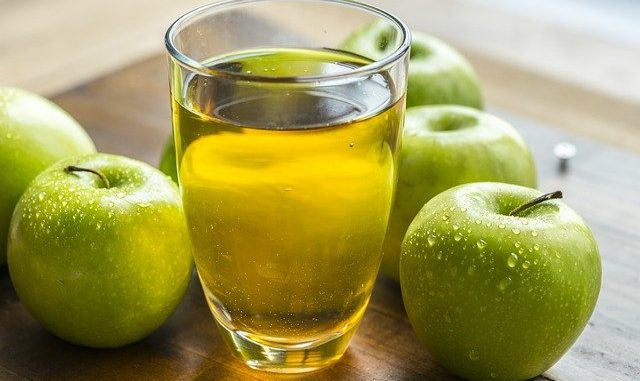
Patulin (4-hydroxy-4H-furo (3, 2-c) pyran-2 (6H)-one) has long been recognised as problem mycotoxin found on mouldy fruits, predominantly apples and pears, some vegetables and other foodstuffs. Patulin is a polyketide lactone based on pyranone and produced by moulds such as Penicillium, Byssochlamys and Aspergillus in brown rots (Zegota et al., 1988). For the food industry, it’s also a potent marker of the quality of fruit being processed. Sound fruit should generally be free of any mould and it is a control measure/pre-requisite to inspect any fruit or vegetable for their presence, as this is a visual indicator that the product may have produced unpleasant metabolites like patulin.
In chemistry terms, patulin forms almost colourless crystals purified from ether extraction. It is soluble in water, alcohols, acetone and ethyl acetate. It melts at 110 °C and in a high vacuum, sublimes at 70 to 100 °C. Yeast fermentation removes it from solution as does the addition of sulphite.
The symptoms of patulin ingestion include agitation and anxiety, at worst convulsions, oedema, ulcers, stomach inflammation and vomiting (Magan & Olsen, 2004). In a number of rat models, the chronic health issues have been toxicity associated with gene function, the immune system and neurology (Cheraghali et al., 2005) but it isn’t clear what the effects are long-term in humans (Wouters and Speijers, 1996).
Apples and their juice products seem to be the most common juices to contain patulin although fruits such as pears and grapes have been identified. Some vegetables, cereals and even cheese have been reported as sources but this is not common. Contaminated apple juice may contain up to 4 mg/litre but it is usually below 50 µg/litre on average with mild fungal infection.
Regulatory Aspects Associated With Patulin
There are prescribed limits for patulin levels in juices. Indeed, evidence must now be presented on fruit juices, that patulin levels are compliant with those defined in the EU Commission regulations (EC) No. 1881/2006 which are 10, 25 and 50 µg/L max (also see EU Regulation No. 1425/2003). allowable content for fruit-based baby food, solid apple products and apple juice respectively. The FDA (Food & Drug Administration, USA) and WHO (World Health Organisation) set a maximum allowable concentration of 50 µg/L or 50 ppb. The FAO/WHO also defined a provisional maximum tolerable daily intake for patulin of 0.4µg/kg body weight/day (WHO, 1995). A number of surveys on collected fruit samples show patulin is present in a large number of them – one survey found 46% of their samples had patulin levels in the juice above the EC defined level of 50 µg/L (Gokman and Acar, 1998). There are some fine reviews on the subject – just look at Moake et al., (2005), Silva et al., (2007) and Puel et al., (2010) for comprehensiveness.
Cider producers probably don’t have much to fear as fermentation destroys the toxin.
Health Issues
Whilst patulin has not been directly linked to causing human illness, a number of studies have identified issues with it (Moake et al., 2005), so careful monitoring of its levels not just for quality reasons is important and developing methods to do so has been a widely reported goal. Liquid chromatography methods have been widely developed mainly for apple juices, for their detection limits down to nanogram per gram levels (MacDonald et al., 2000) which is an AOAC official method. The most recent technique uses liquid chromatography with electrospray ionization tandem mass spectrometry (Desmarchelier et al., 2011) and was validated for baby food products containing apple, pear and cereals.
Agriculturalists are now beginning to understand the genetic organisation underlying the metabolic pathway (Dombrink-Kurtzman, 2006, 2008). Generally, good orchard practise will reduce the impact of mould contamination. Most effective methods for reducing patulin impact rely on fermentation, charcoal addition, addition of preservatives to reduce mould growth, irradiation, a carefully managed supply chain and good quality control. Refrigeration of the fruit is also important to reduce further development of the moulds if it requires storage. Methods have also been sought to remove it from low-grade juice, making it fit for human consumption.
References
Brause, A.R., Trucksess, M.W., Thomas, F.S., Page, S.W., (1996) Determination of Patulin In Apple Juice By Liquid Chromatography: Collaborate Study. J. AOAC Int. 79 pp. 451–455
Cheraghali, A., Mohammadi, H., Amirahmadi, M., Yazdanpanah, H., Abouhossain, G., Zamanian, F., Ghazi, K., Afshar, M. (2005) Incidence of patulin contamination in apple juice produced in Iran. Food Cont. 16 pp. 165–7 (Article)
da Silva, S. J. N., Schuch, P. Z., Bernardi, C R., Vainstein, M. H. (2007) Patulin in Food: State of the Art and Analytical Trends. Revista Brasileira de Fruticultura, 29. doi: 10.1590/S0100-29452007000200043
Desmarchelier, A., Mujahid, C., Racault, L., Perring, L., & Lancova, K. (2011). Analysis of patulin in pear-and apple-based foodstuffs by liquid chromatography electrospray ionization tandem mass spectrometry. Journal of Agricultural and Food Chemistry, 59(14), pp. 7659-7665 (Article)
Dombrink-Kurtzman, M.A. (2006) The isoepoxydon dehydrogenase gene of the patulin metabolic pathway differs for Penicillium griseofulvum and Penicillium expansum. Anton van Leeuw. 89 pp.1–8
Dombrink-Kurtzman, M. A. (2008). A gene having sequence homology to isoamyl alcohol oxidase is transcribed during patulin production in Penicillium griseofulvum. Curr. Microbiol 56, pp. 224–228.
El-Sharkaway, S., Selim, M., Afifi, M., Halaweish, F. (1991) Microbial transformation of zearalenone to a zearalenone sulfate. Appl Environ Microb 57(2)pp. 549–52.
EU Commission Regulation (2003) EC No 1425/2003 of 11 August 2003 amending regulation (EC) No 466/2001 as regards patulin. Official Journal of the European Union L 203 pp. 1–3.
Gokman, V. and Acar, J. (1998) Incidence of Patulin In Apple Juice Concentrates produced In Turkey. J. Chromatography A. 815 pp. 99-102
MacDonald S, Long M, Gilbert J. (2000). Liquid chromatographic method for determination of patulin in clear and cloudy apple juices and apple puree: collaborative study. J. AOAC Int. 83(6) pp. 1387–94.
Magan, N., Olsen, M. (2004). Mycotoxins in food: detection and control. Cambridge, U.K.: Woodhead Publishing.
Moake M.M., Padilla-Zakour O.I. and Worobo R.W.( 2005). Comprehensive review of patulin control methods in foods. Comprehensive Rev. Food Sci. Food Safety. 4 pp. 8 –21.
Puel, O., Galteir, P. and Oswald, I.P. (2010) Biosynthesis and Toxicological Effects of Patulin. Toxins 2 pp. 613-631 doi:10.3390/toxins2040613
WHO (1995) World Health Organization. 1995. 44th Report of the Joint FAO/WHO Expert Committee on Food Additives. In: Tech. Report Series, 859, Geneva, Switzerland.
Wouters, M., Speijers, G. (1996) Patulin. Toxicological evaluation of certain food additives and contaminants. Geneva: World Health Organisation. p 337–402.
Żegota H, Żegota A, Bachman S. (1988). Effect of irradiation on the patulin content and chemical composition of apple juice concentrate. Zeitschrift für Lebensmitteluntersuchung und-Forschung A 187(3) pp. 235–8.
Published: 27th July 2011 @ 10:20 1st revision: 4th September 2013


Leave a Reply